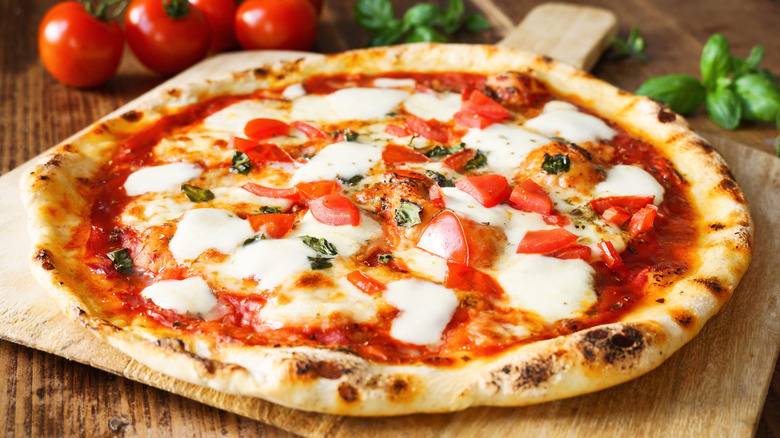Why You Can Never Use Parchment Paper In A Pizza Oven
Parchment paper is an indispensable kitchen tool for all types of cooking and baking. The coated, grease-resistant liner makes transferring cookies and layer cakes to the cooling rack effortless and often saves time from having to scrub a pan clean.
While there are so many applications for parchment paper, using it in a pizza oven is not one of them. Although the paper is meant to be used in an oven, and brands like Reynold's indicate that it's oven-safe, it is so only up to 425 degrees Fahrenheit. The non-stick paper is flammable, so it's not recommended to use in the broiler or toaster oven where it could ignite.
Depending on the brand and type of fuel used in the pizza oven, models like a gas-powered Ooni for example can reach 950 degrees Fahrenheit, cooking Neapolitan-style pizza within 60 seconds. Aside from pizza ovens getting twice as hot as parchment paper is able to withstand, they have an open flame that could cause the paper to catch fire as well, potentially causing injury or damage to your property.
Try 'launching' your pizza instead
While parchment paper won't work for transferring pies to and from the pizza oven, there are other ways. One of them is 'launching,' which refers to the act of transferring the pizza dough from the peel (aka the large wooden paddle) into the oven. With a generous amount of flour, a preheated oven, and a few tips, the raw dough will slide off effortlessly from the peel into the hot contraption to be cooked.
This technique begins with using quality dough — using finely milled OO flour is easier to work with and will allow the pizza to stretch. Although it can be stored in the refrigerator, the dough should be at room temperature when you work with it. If it gets too warm, it will stick to the peel.
If you are making multiple pizzas, use two of the paddles — one to put the dough into the oven and another to take it out. This prevents the hot tool from causing the raw dough to sweat, gluing it to the surface.
There should also be a thin layer of flour between the dough and the peel to avoid sticking. Before adding toppings, lift the flattened dough again to ensure it's not adhering to the wooden surface, and add more flour if needed. Pinch holes or tears in the dough before saucing, too — this prevents the pizza from freely sliding.
Finally, just before you launch the pie, lift the edge closest to you and blow under the dough to allow it to glide on the trapped air into the oven. It's essential to do this process quickly to prevent the dough from getting warm and absorbing the sauce.
What else can you put in a pizza oven?
If you thought your pizza oven was a one-trick pony, prepare to fire it up more often. Not only can it deliver leopard-spotted pizza dough and calzones, but the high heat is perfect for cooking meat, veggies, bread, and more.
For example, you can cook restaurant-quality steaks and chops in under 10 minutes (just use a cast iron skillet to catch the drippings). The extreme temperature and a preheated pan will ensure a flavorful crust on thick cuts of meat. While the steaks rest, make a pan sauce with the drippings, butter, and fresh herbs.
The high heat also produces deliciously charred veggies. Use a cast iron pan to sauté vegetables like onions, peppers, eggplant, carrots, and squash. While the oven is still hot, you could also throw in some mac 'n cheese with a buttery breadcrumb topping for a few minutes until it's golden brown and crispy.
Baked goods can be made in a pizza oven, too, using a baking stone or metal pan. Turn pizza dough into focaccia by dimpling the surface and adding olive oil and plenty of salt. Or quickly cook flatbreads like naan, roti, and manoushe seasoned with Za'atar directly on the stone. If you have a sweet tooth, you're not limited to savory dishes by any means. By lowering the temperature, the oven can bake desserts like galettes and cookies, just like a kitchen oven.



